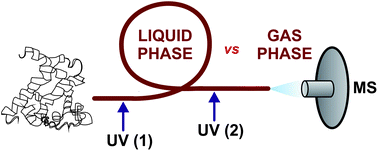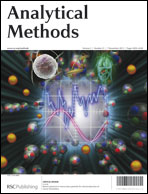Liquid-phase and gas-phase investigation of biomolecules in a single experiment†
Abstract
Interrogating three-dimensional structures of biomolecules is instrumental to the fields of biochemistry and biophysics. Mass spectrometry is a technique that can provide important data on the molecular weight of protein molecules in the gas phase. However, the relationship between the structure of biomolecules in the native water-rich environment and the artificial gas-phase environment cannot always be established with high certainty. Here we communicate initial results obtained using a simple analytical approach which allows one to perform measurements of structural parameters of biomolecules in liquid phase and gas phase within a single experiment. Single-component samples are injected as plugs to a microscale capillary filled with aqueous medium and driven hydrodynamically. As they traverse the capillary, they undergo zone broadening. The extent of this broadening is measured at two points along the capillary by UV absorption detection, and used to compute hydrodynamic radii according to the Taylor dispersion analysis theory. Further downstream, the dispersed zones leave the capillary through the sharpened outlet aligned to the orifice of a mass spectrometer. This multiple detection strategy allows one to confront protein conformation in the liquid phase (deduced from the hydrodynamic size) and the gas phase (deduced from mass spectral patterns).


 Please wait while we load your content...
Please wait while we load your content...